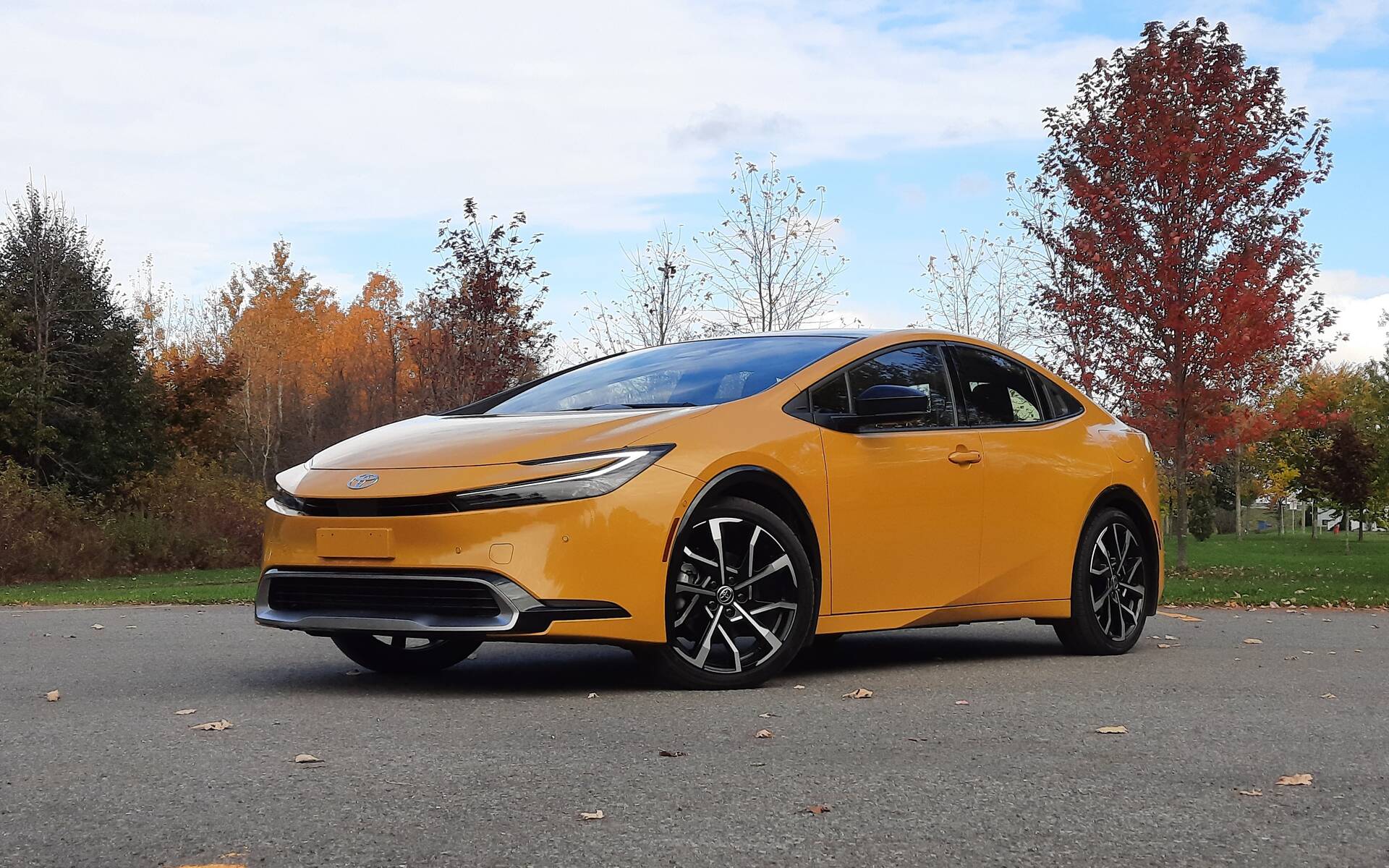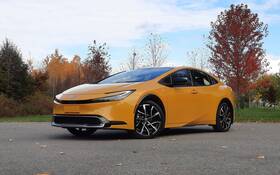2024 Toyota Prius Prime: Positively Exotic and Efficient

| Strong points |
|
|---|---|
| Weak points |
|
Toyota is no longer the maker of boring cars it used to be. Yes, there have been some exceptions featuring bold designs and fancy parts. The wedge-shaped, previous-generation Prius is one example, but in that case the company seemingly tried to do too much (or just didn’t know what to do) and failed miserably.
Now, this completely redesigned Prius? Wow. The venerable hybrid has morphed into a seriously attractive product with some exotic-car vibes. In fact, if it weren’t for the name, everyone would simply assume it’s a different vehicle altogether.
The Prius Prime plug-in hybrid that we took for a spin in late October was flashier than fall’s colourful foliage—not only because of the Maximum Yellow exterior, but also the magnificent 19-inch wheels our top-line XSE Premium tester was decorated with. The latter add to the car’s athletic stance and almost sexy body, while the new-look headlights are extremely sharp and eye-catching. The Prius still has that high tail in the back, though more in a coupe-like profile with hidden rear door handles.

On the Road
Compared with its predecessor, which felt content riding on small 15-inch wheels, the new, lower-slung and heavier Prius Prime (it carries an extra 100 kg or so) is more agile on the road but also has a firmer ride. It’s not unpleasant thanks to Toyota’s new TNGA-C platform and clever tuning by engineers, but the difference is fairly noticeable. If you want a smoother experience, the base SE model and its 17-inch wheels are exactly what you need.
The increased output makes a world of difference, too. Previously limited to 121 horsepower, the Prius Prime now generates a combined 220 horsepower, while peak torque is improved by 32 percent. Granted, pure electric acceleration isn’t as quick as we’d hoped, but when the new 2.0-litre four-cylinder engine kicks in, the result is quite pleasing. It’s just a shame the plug-in hybrid variant has to settle for FWD whereas the regular Prius now comes standard with e-AWD.

Sure enough, the Prius Prime excels when it comes to braking. Not only that, but the energy recuperation system isn’t intrusive at all. If you’re satisfied with the base SE model, the new 13.6kWh high-voltage battery will provide a zero-emission range of 72 km, which is fantastic. Due to the added weight and larger wheels, range drops to 64 km in XSE trim, a number we were able to validate a couple of times during the week despite the cool temperatures. It’s a reasonable tradeoff, in our opinion.
By the way, the Prius Prime achieves 5 L/100 km or better when the battery runs empty. A full charge takes 4 hours when plugged into a 240V wallbox or up to 11 hours—basically an entire evening and night—when using a standard 120V power outlet.
Inside the Prius Prime
The interior transformation the Prius Prime went through is just as remarkable. First of all, hats off to Toyota for the new infotainment system with clear, easy to read graphics, driver-friendly menus, as well as many available connected services including a virtual assistant. Wireless Apple CarPlay and Android Auto connectivity is there if you prefer.

Under the touchscreen (8 or 12.3 inches in size depending on the model), physical controls allow quick, intuitive adjustment of the HVAC system and heated/ventilated seats. As for the digital instrument cluster now mounted in front of the driver but still close to the base of the windshield, we’re glad it’s not as obstructed by the steering wheel as the one in the bZ4X electric crossover.
On that note, the driving position in the new Prius Prime is likely to cause problems for a number of people. Because of said instrument cluster, the steering column has limited height adjustability. Also, there’s little headroom at your disposal if you want to raise the driver’s seat (especially when the sunshade for the glass roof is closed), but lowering it all the way down means you no longer see the car’s corners, which can be tricky in tight spots and parking manoeuvres. Furthermore, visibility out the rear window is extremely limited, similar to a sports car. A digital rear-view mirror would have been nice. Maybe next year, Toyota?
We liked how our tester’s red interior accents spiced things up a bit in an otherwise dark cabin. The centre console is narrow yet still incorporates a wireless charging tray where you put your smartphone facing sideways. That piano black finish atop the console won’t stay immaculate very long, however, while the tiny drive mode switch is hard to locate without taking your eyes off the road.

Primed for More Success
Drivers who simply want an efficient sedan can turn to the Corolla Hybrid, leaving the new Prius as the cool, stylish and more premium alternative. The Prime variant, meanwhile, is the only mainstream plug-in hybrid car on the market right now. The duo is aimed at long-time Prius fans, but it’s sure to attract new customers at the same time with head-turning looks on top of improved technology and capability.
When it comes to pricing, the 2024 Toyota Prius Prime SE starts at $41,931 (including freight, PDI and dealer fees). The XSE model at $46,631 offers several desirable extras such as SofTex synthetic leather, 8-way power driver’s seat, heated rear seats, a wireless charger and glass roof. The XSE Premium package retailing from $50,431 will satisfy those looking for the most bells and whistles—or that bright yellow paint reminiscent of an Italian supercar.
Just one more thing: the Prius Prime is eligible to a $5,000 rebate from the federal government’s iZEV program plus local incentives where applicable. Strong demand means delivery times can be just as long as the RAV4 Prime’s.











